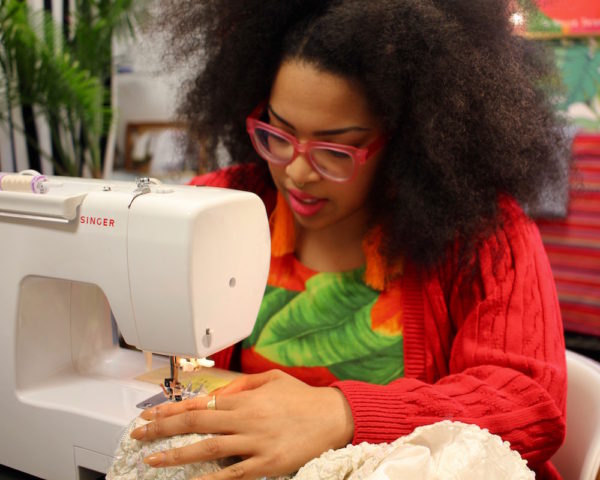Drea Johnson, founder of Hidden Opulence Design House, uses her repair skills to help garments live their longest and best lives.
Drea Johnson’s studio boasts a serious disco ball collection – five, of varying sizes, arranged amongst neatly folded swaths of bright fabric – and that’s just on one bookshelf. “It’s pretty fun when the sun comes through that window,” Johnson says, laughing.
Even when the sun isn’t shining, the room is a bastion of brightness. Large potted plants give the illusion that the wallpaper of large-leafed monstera and ferns is spilling from two dimensions into three. Woven draperies and bold upholstery bracket the walls, chairs, and curtains of a small changing room. During our visit, Johnson herself wears a plant-patterned shirt and a vivid red cardigan. She is clearly in her element – this bright space, Hidden Opulence Design House, is her creation and domain.
Hidden Opulence is located in the back room of Artifact Creative Recycle, a buy-sell-trade vintage store, where Johnson was originally hired on as an in-house seamstress. Thanks to her repair skills, Johnson explains, Artifact can buy-in more now; she can fix hems, buttons, or other damaged elements of an otherwise functional garment. While she still repairs for Artifact, Johnson has grown from a member of their upcycling team into her own operation.
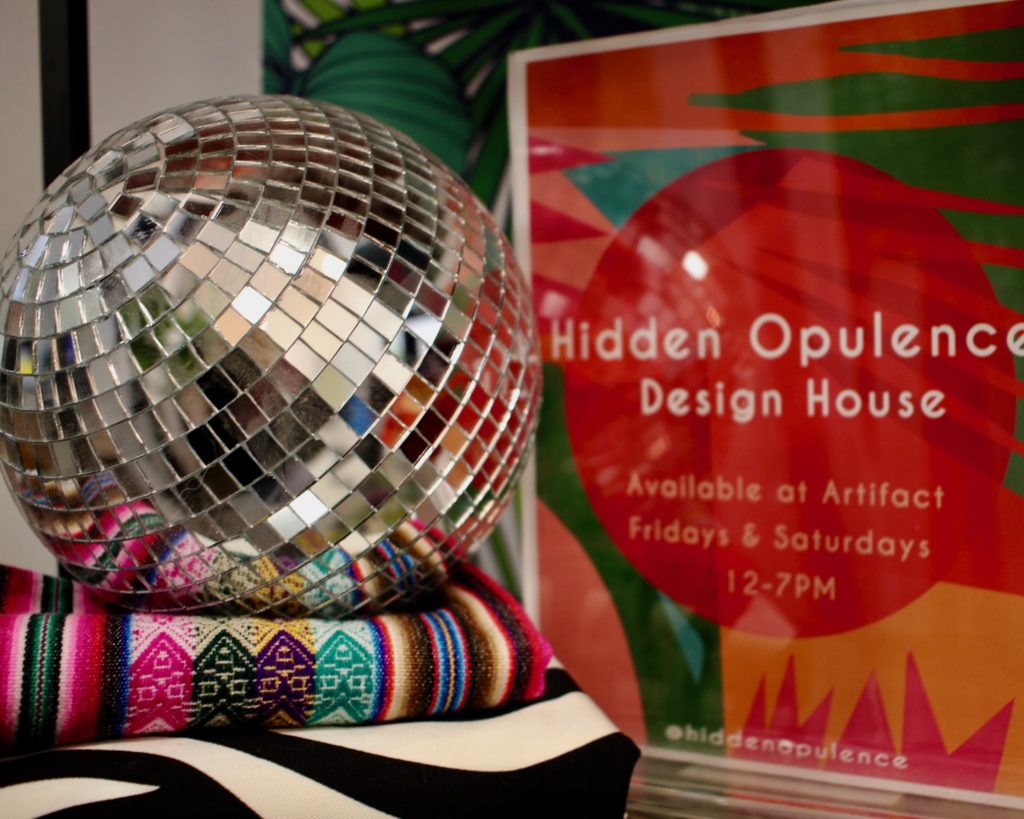
One of many disco balls.
Portland Repair Finder sat down with Johnson to talk about the work that she does, her relationship to sustainability through garments, mending, community, and more.
PRF: What is Hidden Opulence? In a nutshell, what do you do?
DREA: Hidden Opulence is a sustainability focused alterations pop-up that serves both local apparel brands and the Portland community at large. We do a little bit of everything – from basic mends, alterations, and repairs, to reworking and upcycling clothing and home goods, to refurbishing vintage pieces. For the apparel business folks, we provide production assistance for wherever they are, whether it be in-house support, piece work or small batch production.
In terms of individual people, they can come in with a garment and say, “Oh, I love this, but it doesn’t fit my body type,” etc, and we talk about what other things they wear, what their style is. And I alter things. We can have a conversation about what can be done to make it work for them. Like, “Oh, we can make this a little bigger, we can splice this in half and make it a two piece, we can take a little from the shoulders.” I love that. I love just talking about what is possible and what it will take to extend this garment’s life and make it a piece that’s really valuable in someone’s wardrobe.
PRF: Who do you feel like your audience is? Who are you working to help?
DREA: I’ve been saying this phrase for the past couple months, “You can’t be what you can’t see.” People who are wanting to be fashionable, but they aren’t seeing anyone out there who represents them… I want to empower them. I love being the catalyst for people who bring a garment to me and are like “Do you think this is too loud?” I’m like “Do YOU think it’s too loud? Maybe we need to go louder.”
I want to empower people. This is going to be on your body, this is your message, you will be presenting it, not me. You can walk away. But I’m never going to turn someone away for a project unless it is physically impossible. I do want to be realistic for people – for example, altering a garment will change the look, and it might not read the same style. And also, I want to be honest about the investment for them. Like, will they wear it a lot, is it worth it, or should they walk away? It comes down to cost-per-wear. Is it something that you want to invest in for the long term?
I always think, too, about legacy pieces, about investing in something not only for yourself, but so that you can wear it and then hand it down to someone else. It’s a powerful thing to have a piece you want some human after you to wear into the future, so they can look at it and think, “This is our dress and culture.”
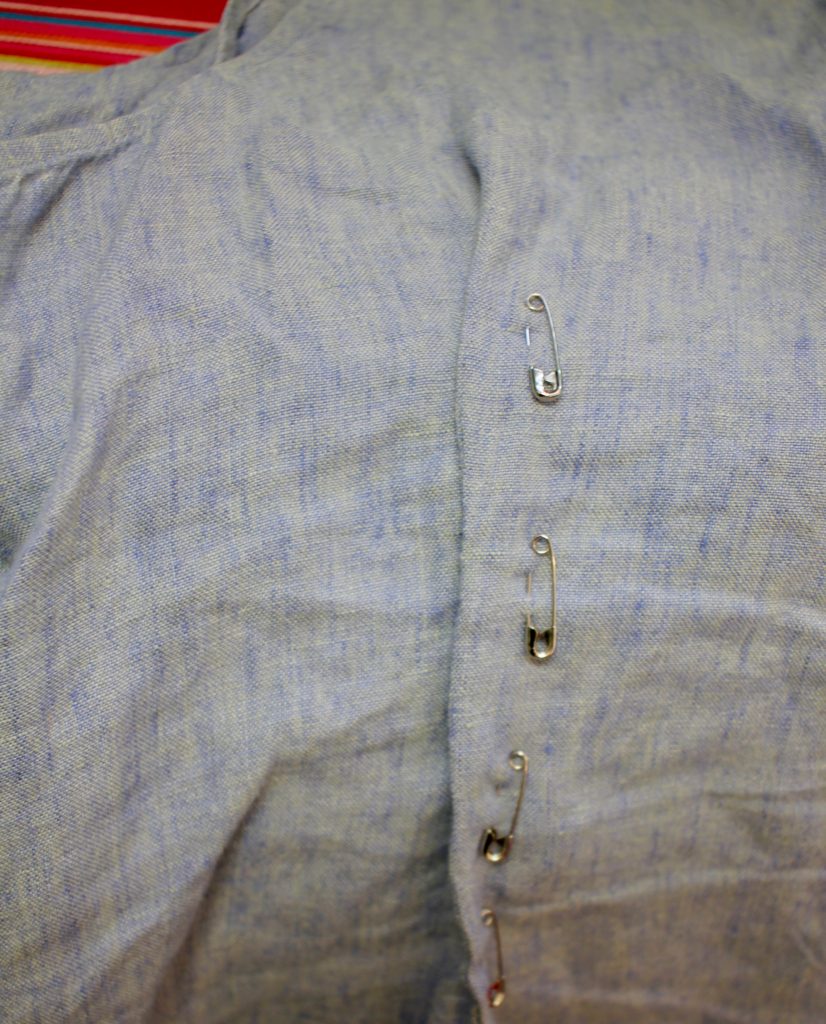
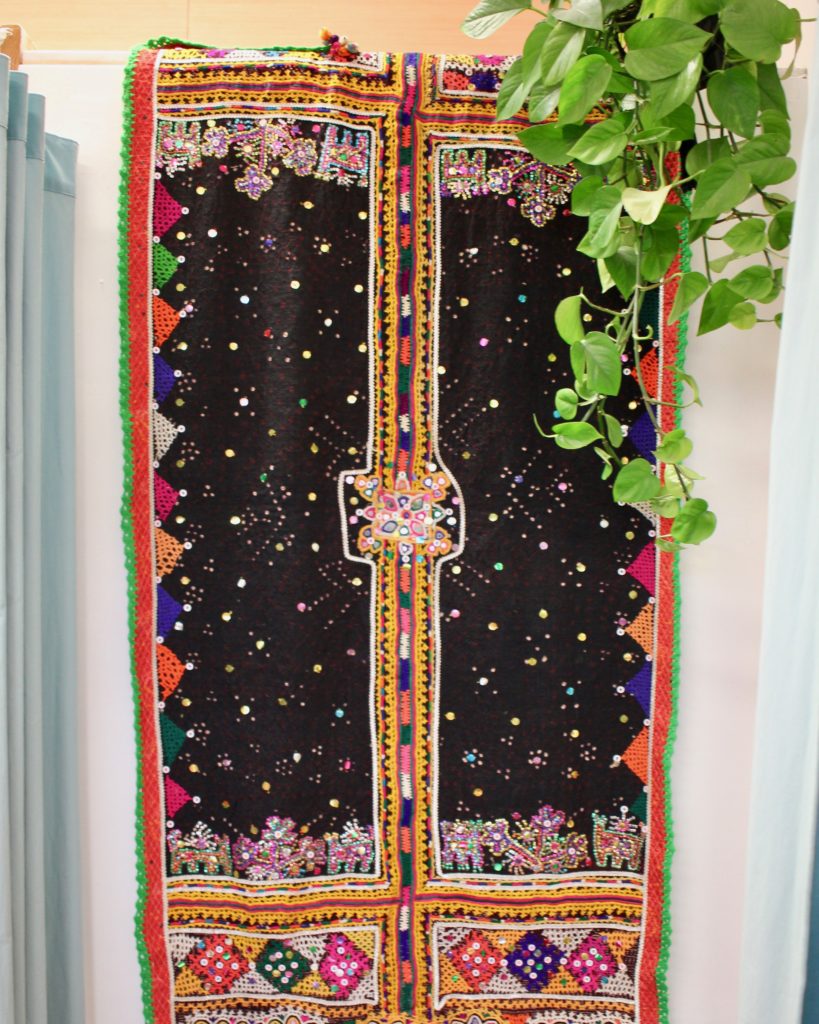
Johnson’s studio offers a fitting room for visitors seeking alterations.
PRF: Is there ever any garment that you think is not worth saving?
DREA: In terms of things that people bring in, I have to look at the fabric and test it, and if it’s just, like, going, that’s when I’m like “Ok, how much does this mean to you? Is there any way we can take this off and apply it to something else?” If it makes you happy, let’s do anything we can do to save it. We can take a little piece and, I don’t know, put it on a laptop cover, notebook, something, where you can look at it and be happy. In those instances I’m like, “how do we keep this in your life?”
PRF: Recently, you held a “mending mixer” in your space for community members to come in and fix their clothes together. How did that go?
DREA: I was so nervous, I don’t know why I get nervous! It was great. It was literally people with questions like “I have a hole in this sweater, how do I fix it?”And I was wandering around basically giving everybody tips to work on their stuff.
There were definitely some folks in attendance too who had some pretty ample knowledge. Sewing oftentimes is not very social, so I think those people were having a good time being around other people. And then some other people would come in with something like embroidery floss and a sweater and an idea they’ve had, and they’ve been sitting on it because they weren’t sure how to execute it. They just needed that little push to start. I was like, “Let’s talk it through and get it going. I’ll even start it for you, and hand it to you, and you can go.”
There was a jeans fly zipper repair, which used to be very intimidating to me. Everything used to be very intimidating to me! I didn’t think I would be doing this back in college. Industrial sewing machines used to scare me. So I get it. Anyway, she was like, “What do I do? I don’t want to undo too much.” I was like, “Give me the jeans,” and I just ripped the fly all the way open. Everyone’s eyes went, “Whoaaa.” I was like, “It’s gonna be okay. It’s already broken. Seam ripping takes too long. We can do this.”
It’s such a valuable skill to be able to mend your own things. I want to empower people to do that. I also have people who come in here to like, have me sew buttons back on, and they’re like, “My grandmother would be so pissed.” But I’m like… “Your grandma’s happy you even thought about putting the buttons back on. She would be happy this is not in the trash.”
I’m also happy to explain things to people who already know how to do it, give them the order of operations, draw them a diagram. Sometimes people who have all the tools and skills just need that affirmation of knowing where to start.
PRF: What is your own relationship to sustainability in fashion – which can be such a disposable, turn-and-burn industry?
DREA: I swap so much. I’m always going to clothing swaps. And I love me a free box… I will dye something, I will cut it, I will do anything to it. I share clothes with my friends. I buy clothes here (at Artifact), I’ll change them, sell them for store credit, and then I’m shopping again.
I do my trend research. I take a stroll through the mall, I’m looking around. I’m not buying anything, because I know too much, and once that’s the case, you can’t unsee it.
But I’m also looking at IG and Pinterest for what the trends are currently, and here in Artifact I’m looking for things that are mimicking that, and saying maybe, “I like this trend, but I’m going to mesh it with these colors,” or whatever. I’m at the point where I’m making it easy for myself to always shop at thrift stores and always be changing and mending. But I know for many people, it’s a convenience thing to buy clothes new. I know that’s why the system is the way it is, because they’re feeding people “This is what’s in,” and it’s so easy to buy that one thing and wear it. People are always thinking “This is cool,” but not often thinking, “Is this me?”
The fast fashion machine is so big now. There’s an insane amount of seasons. You know how they say, when you’re scrolling online, you don’t absorb anything? There’s just too much to actually absorb something in any meaningful way? That’s how I feel fashion is right now. There’s too much to look at.
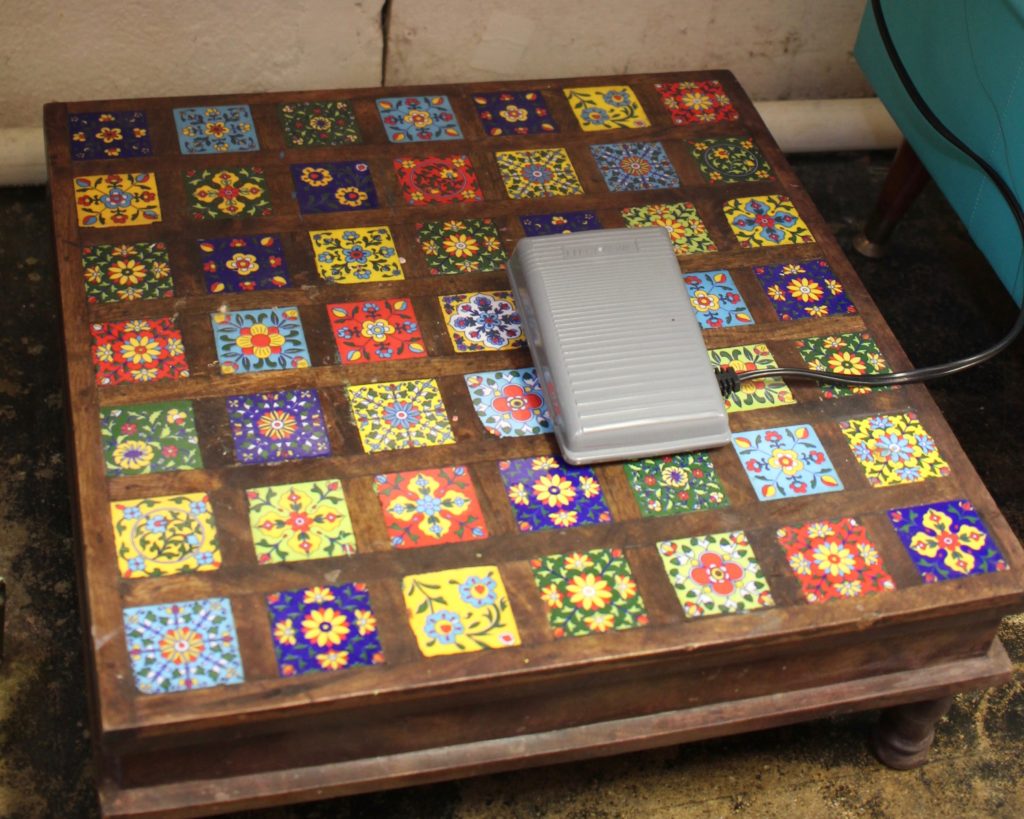
A sewing machine foot pedal rests on Johnson’s fitting pedestal.
PRF: What’s going through your head at the mall? What is it you “can’t unsee”?
DREA: At the mall, I’m thinking, “I don’t know anything about the people who are making these things.” Fast fashion has brainwashed us to believe that shirts are $2, or $5… none of that is true. It’s such a colonized concept, getting cheap labor elsewhere. I’m always thinking about the people. Who touched this, how many hands touched this, what is the factory like, what are their ages. I also think about the origin countries, what things are like where these clothes were produced. And thinking about how few times people will actually wear this or that thing.
PRF: How do you see Hidden Opulence as a “first step in the door” for people new to thinking about sustainable fashion?
DREA: Well, people physically come into the space through Artifact. So they’re already shopping vintage, they already have that mindset, and then they can bring a piece back here, like this sequined top… It’s a great piece, but the stitches are coming out, which is only natural, because it’s super old. (laughs)
Artifact is buy-sell-trade, so if you sell and have credit in the front of the store, you can use that credit with Hidden Opulence. So if you have some items that you don’t wear or want, but they have value, you can trade them up and then use that credit toward making a garment that you really really love work for you. And be something that will last for a long time, that you’ll wear for a long time.
Maybe all you need is to mend a couple things in your wardrobe and be like, “Oh, I’ve spent this amount now,” all in sustainable ways, that extend the life and use of your item. And maybe that’s the first seed that you need planted to consider the whole system a little differently. And Hidden Opulence can be that step for you.
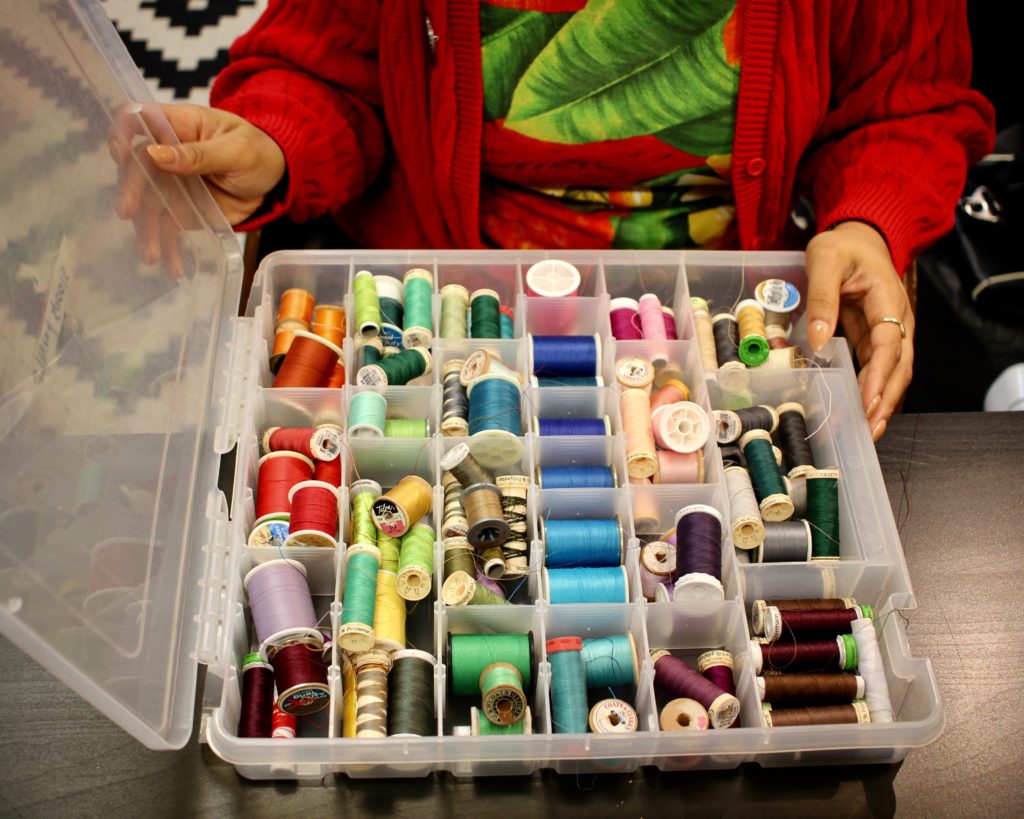
“But it’s so messy right now!” Johnson laughs as her thread box is photographed.
